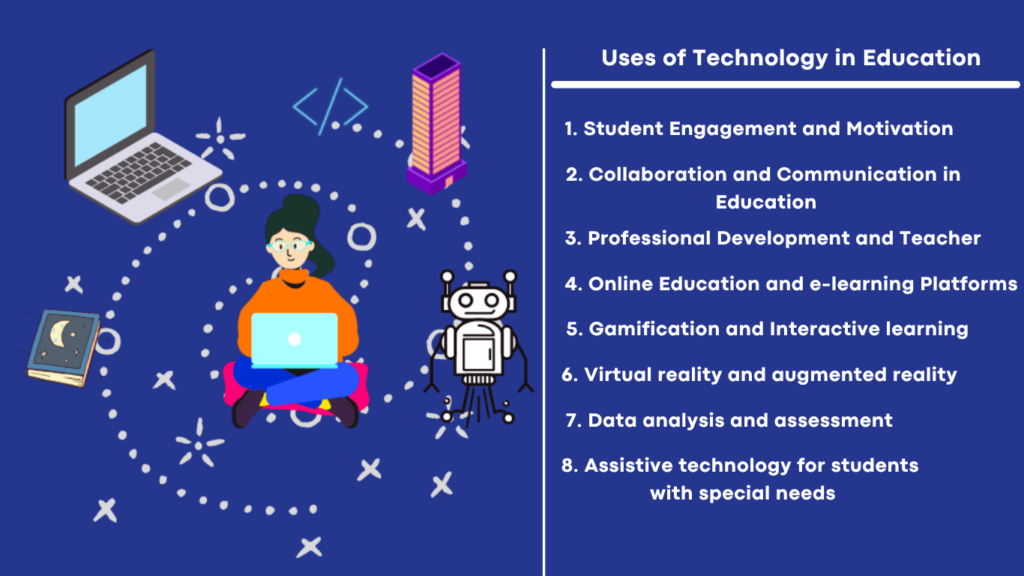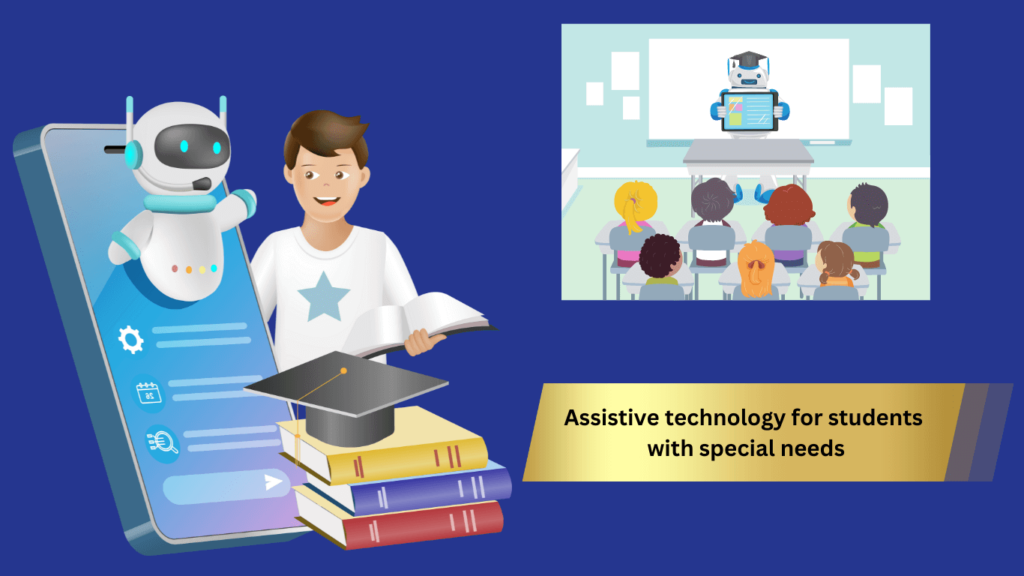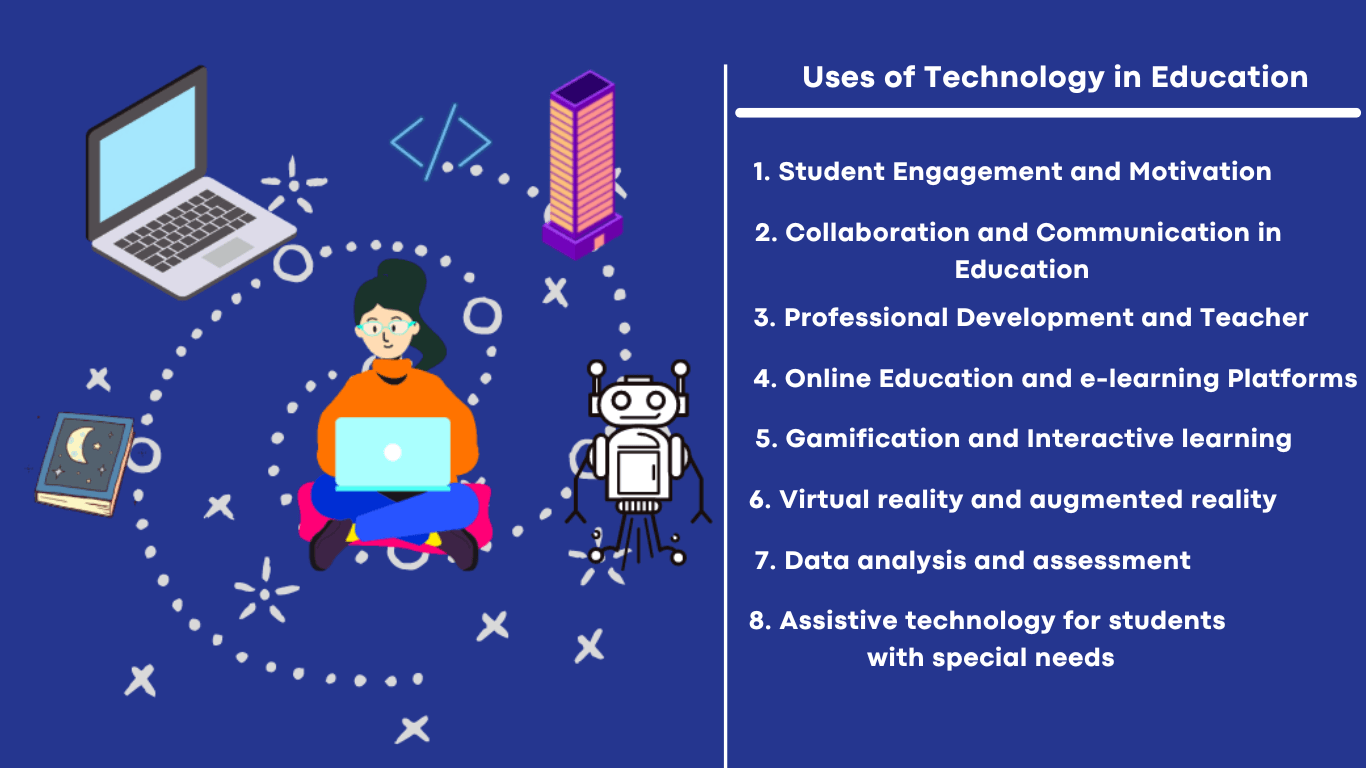Uses of Technology in Education : In today’s digital age, technology has become an integral part of our lives, revolutionizing various sectors, including education. The use of technology in education has transformed the way we teach and learn, enhancing the overall educational experience.

With the ever-growing advancements in technology, educators have been able to leverage its power to create a more personalized and engaging learning environment for students.
Technology also enables students to have access to a vast array of educational resources beyond the traditional classroom setting. Online libraries, educational websites, and digital textbooks offer a wealth of information that students can access anytime, anywhere. This not only broadens their knowledge base but also encourages independent learning and self-motivation.
Uses of Technology in Education
1. Student Engagement and Motivation
Traditional classroom settings often struggle to capture and maintain students’ attention, leading to disengagement and lack of motivation. However, technology provides educators with a wide range of tools and strategies to make learning more interactive and exciting.
Another aspect of technology that enhances student engagement is the use of multimedia presentations and interactive learning materials. Instead of relying solely on traditional lecture-style teaching, educators can incorporate videos, animations, and interactive simulations to make the learning process more dynamic and engaging.
2. Collaboration and Communication in Education
In today’s interconnected world, effective communication and collaboration skills are essential for success. Technology provides educators with various tools and platforms to facilitate collaboration and communication among students, both within and beyond the classroom.
Online platforms and mobile applications enable teachers to communicate important announcements, assignments, and feedback to students and parents in a timely manner. This improves transparency and keeps all stakeholders informed about the progress and challenges faced by students.
3. Professional Development and Teacher Support
Just as technology has transformed the learning experience for students, it also plays a crucial role in professional development and support for educators. Continuous professional development is essential for teachers to stay up-to-date with the latest pedagogical practices and enhance their teaching skills.

Technology provides educators with access to a wealth of online resources, such as webinars, online courses, and educational blogs. These resources offer opportunities for self-directed learning, allowing teachers to explore new teaching strategies, instructional technologies, and research-based practices. Online communities and social media platforms also enable educators to connect with peers and experts from around the world, sharing ideas and best practices.
Technology enables teachers to collect and analyze data on student performance, helping them make data-informed instructional decisions. Learning management systems and educational software provide teachers with insights into students’ progress, allowing them to identify areas of strength and areas that need further attention. This data-driven approach to teaching enables educators to tailor instruction to individual students’ needs, ensuring that each student receives the support they require to succeed.
4. Online Education and e-learning Platforms
Online education has gained immense popularity in recent years, offering flexibility and accessibility to learners of all ages and backgrounds. E-learning platforms provide a wide range of courses and programs, allowing students to learn at their own pace and convenience.
One of the significant advantages of online education is the flexibility it offers. Students can access course materials and lectures anytime, anywhere, allowing them to balance their education with other commitments, such as work or family responsibilities. This flexibility eliminates geographical barriers and enables learners from diverse backgrounds to pursue their educational goals.
E-learning platforms also provide a variety of multimedia resources, including videos, interactive quizzes, and discussion forums, to enhance the learning experience. These resources cater to different learning styles and engage students in active learning, promoting a deeper understanding of the subject matter.
5. Gamification and Interactive learning
Gamification is a powerful tool that has been widely adopted in education to enhance student engagement and motivation. By integrating game elements, such as points, badges, and leaderboards, into educational activities, teachers can make learning more interactive and enjoyable.
Gamified learning not only captivates students’ attention but also encourages healthy competition and a sense of achievement. Students are motivated to complete tasks and earn rewards, which promotes active participation and a desire to excel. Gamification also fosters critical thinking and problem-solving skills, as students are required to strategize and make decisions within the game context.
6. Virtual reality and augmented reality
Virtual reality (VR) and augmented reality (AR) are cutting-edge technologies that have the potential to transform the way we teach and learn. These immersive technologies provide students with a realistic and interactive learning experience, enabling them to explore virtual worlds and interact with digital objects.
Virtual reality allows students to step into a simulated environment, fully immersing themselves in the learning experience. For example, students can explore historical sites, visit distant planets, or even dissect virtual organisms. This hands-on approach to learning not only captivates students’ attention but also enhances their understanding and retention of the subject matter.
7. Data analysis and assessment
Data analysis plays a crucial role in education, providing valuable insights into student performance and informing instructional decisions. Technology facilitates the collection, analysis, and interpretation of data, enabling educators to make data-informed decisions to improve learning outcomes.
Learning management systems and educational software collect data on student performance, such as grades, completion rates, and time spent on tasks. This data can be used to identify students who may be struggling or excelling, allowing teachers to provide targeted support or enrichment. By analyzing patterns and trends in student performance, educators can uncover areas that need improvement and adjust their instructional strategies accordingly.
Data analysis helps to identify trends and patterns in student performance at a macro level. By analyzing data across classrooms, schools, or districts, educators can identify systemic issues and make data-informed decisions to improve educational outcomes. For example, data analysis can identify achievement gaps among different student groups, leading to targeted interventions and support.
8. Assistive technology for students with special needs
Technology has revolutionized the way students with special needs access education and participate in the learning process. Assistive technology provides students with the tools and resources they need to overcome barriers and reach their full potential.
For students with visual impairments, screen readers and braille displays enable them to access digital content and participate in online learning. These assistive technologies convert text into speech or braille, allowing students to navigate websites, read e-books, and complete online assignments. Additionally, computer software and apps provide tools for students with visual impairments to create and edit documents, enhancing their independence and productivity.

Inclusive classroom practices are further supported by technology that allows for differentiated instruction. Learning management systems and educational software provide teachers with the ability to customize learning materials and activities to meet individual students’ needs. This ensures that students with special needs receive the necessary accommodations and support to succeed in the classroom.
Conclusion : Uses of Technology in Education
The transformative power of technology in education is undeniable. From enhancing teaching and learning to promoting student engagement and collaboration, technology has revolutionized the educational landscape. By leveraging the various uses of technology, educators can create personalized, interactive, and inclusive learning environments that foster a love for learning and prepare students for success in the digital age.
As technology continues to advance, it is essential for educators to embrace its potential and integrate it effectively into their teaching practices. Professional development and support for teachers in utilizing technology are crucial to ensure that its benefits are maximized and that all students.

